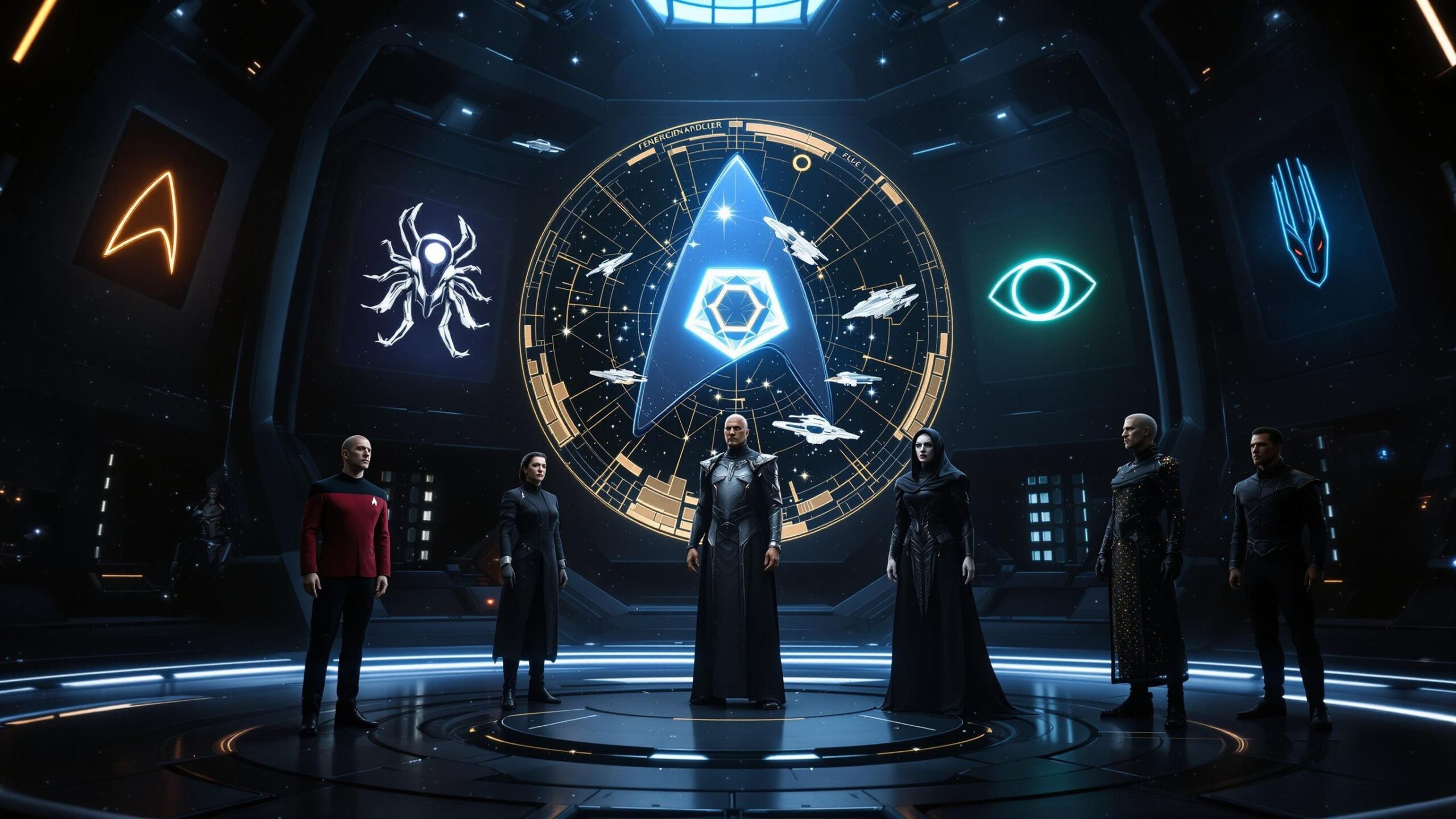While Star Trek is known for diplomacy, exploration, and moral dilemmas, the franchise has also delivered some of the most thrilling espionage stories in science fiction. Cloaked in secrecy, deception, and high-stakes infiltration, these missions often blur the lines between right and wrong, loyalty and betrayal. From undercover assignments behind enemy lines to intelligence-gathering missions that reshape galactic politics, espionage in Star Trek reveals a hidden world beneath the utopian surface—one filled with shadowy agencies, double agents, and ethical gray zones. These are the Top 10 Most Legendary Espionage Missions in Star Trek, where courage meets covert operations, and one wrong move could mean galactic catastrophe.
#10: Worf Infiltrates the Dominion Prison – DS9: “In Purgatory’s Shadow” / “By Inferno’s Light”
When Garak intercepts a distress call from Enabran Tain, a mission is launched to rescue him from a Dominion prison in the Gamma Quadrant. Worf, Garak, and others are captured in the process, leading to one of the most intense undercover arcs in DS9. While not espionage in the traditional sense, the mission exposes critical secrets: Dominion plans for invasion, changeling infiltrators in Starfleet, and the devastating revelation that General Martok and Dr. Bashir have been replaced by impostors. The psychological and physical toll is immense—Worf is forced to fight Jem’Hadar soldiers in brutal duels while Garak risks death to send a message from a sealed wall compartment. This mission combines intelligence-gathering, subversion, and survival in one of Star Trek’s darkest and most harrowing storylines.
#9: Discovery’s Time Travel Espionage – Discovery: Season 2 Finale
In Star Trek: Discovery, the Section 31 AI known as Control poses an existential threat to all sentient life. To prevent it from obtaining the Sphere data, Michael Burnham and her crew conduct a complex espionage mission that involves not just infiltration—but time travel. Using a Red Angel suit, Burnham seeds signals across time to guide Discovery toward its mission’s ultimate goal. The entire season culminates in an intelligence operation across time and space, blending espionage with science fantasy. Though grand in scale, it hinges on classic spy tropes: coded messages, misdirection, covert tech, and last-minute escapes. The implications stretch across the multiverse, redefining Starfleet’s entire timeline—and proving espionage can be existential.
#8: The Romulan Defection – TNG: “The Defector”
When a high-ranking Romulan named Admiral Jarok defects to the Federation claiming that the Empire is planning to invade, Captain Picard must tread carefully. The episode turns into a cerebral spy thriller—full of double bluffs, tense diplomacy, and the looming threat of war. Jarok provides sensitive information that leads the Enterprise into the Neutral Zone, but the mission unravels when it’s revealed he was being used by his own government in a disinformation plot. The Romulans never intended to attack—their goal was to expose the Federation’s vulnerability. Jarok’s tragic fate, choosing defection only to be used and abandoned, underscores the human cost of espionage. This mission is legendary for its quiet tension, political complexity, and its ultimate revelation: sometimes, the truth is the most dangerous weapon of all.
#7: Odo’s Undercover Operation in the Orion Syndicate – DS9: “Honor Among Thieves”
Chief O’Brien goes deep undercover into the Orion Syndicate—a powerful criminal network known for blackmail, assassination, and corruption across both the Federation and the Dominion spheres. Disguised as a down-on-his-luck engineer, O’Brien is drawn into the inner workings of a ruthless organization and develops a bond with an innocent man caught in the crossfire. The mission has all the hallmarks of noir espionage: fake identities, coded meetings, moral conflict, and a tragic ending. O’Brien is forced to betray a man he considers a friend to complete the mission. The emotional toll, the moral ambiguity, and the grim realism of this mission make it one of Star Trek’s most powerful—and most painful—spy stories.
#6: The Vulcan Mind-Control Conspiracy – Enterprise: “The Kir’Shara Trilogy”
T’Pol, Captain Archer, and others uncover a sinister plot within the Vulcan High Command involving the suppression of ancient teachings and militarization of Vulcan society. Archer becomes the key to smuggling the ancient Kir’Shara artifact, which holds the true writings of Surak, back to the Vulcan capital. The mission involves evading surveillance, decoding ancient texts, and fighting both physical and ideological battles. Archer is even temporarily merged with Surak’s katra, gaining strategic insight into both politics and philosophy. The operation ultimately topples the corrupt government and restores Vulcan to a path of logic and peace. Its espionage fueled by cultural revolution, and it redefines Vulcan’s place in the galaxy.
#5: The Klingon Infiltration of Starfleet – DS9: “Apocalypse Rising”
When suspicions arise that Chancellor Gowron has been replaced by a Changeling, Captain Sisko assembles an elite team—including Odo, O’Brien, and Worf—to go deep undercover within the Klingon Empire. Using disguises and forged identities, the team infiltrates a massive Klingon military ceremony aboard Ty’Gokor, the most secure installation in the Empire. Their objective: expose the imposter and prevent a war between the Federation and the Klingons. The mission is a tense blend of spycraft and diplomacy, with the team constantly at risk of discovery. What makes this mission legendary is the twist—it’s not Gowron who’s the Changeling, but General Martok, a trusted ally. The revelation reshapes the political landscape and changes how the Dominion threat is perceived. It’s Star Trek espionage at its finest: secret missions, mistaken identities, and galactic consequences.
#4: Section 31’s Genetic Manipulation of Dr. Bashir – DS9: “Inter Arma Enim Silent Leges”
In this gripping Cold War-style episode, Dr. Julian Bashir is recruited—unwillingly—by Section 31 to attend a medical conference on Romulus. But the true mission is far more sinister. Under the watchful eye of Sloan, Bashir becomes a pawn in a web of lies, misdirection, and manipulation intended to destabilize Romulan politics in favor of Federation security. What begins as a diplomatic gesture spiral into assassination attempts, fake intelligence, and ethical compromise. Bashir discovers he’s been used to discredit a Romulan senator and install a pro-Federation leader on the Continuing Committee. The title— “In times of war, the law falls silent”—perfectly encapsulates the moral rot behind Section 31’s rationale. This mission is legendary for its narrative depth, philosophical weight, and for presenting one of Star Trek’s most disturbing truths: in the shadows, even Starfleet has fangs.
#3: Kirk and Spock Go Undercover on Organia – TOS: “Errand of Mercy”
During a tense standoff between the Federation and the Klingon Empire, Kirk and Spock beam down to the seemingly primitive world of Organia to convince the locals to accept Federation protection. Disguised as commoners, they attempt to resist a Klingon occupation led by the brutal Commander Kor. Their covert activities include sabotage, coded communications, and psychological manipulation. But the true twist comes when the Organians reveal themselves as powerful non-corporeal beings who view war itself as barbaric. They instantly disable both fleets, forcing a peace treaty. While the espionage here is more surface-level, the mission’s legendary status comes from its message: sometimes, higher powers render covert warfare—and even galactic conflict—obsolete. It’s classic Star Trek: an espionage story that ultimately critiques the need for espionage at all.
#2: The Cardassian Rebellion’s Secret Alliance with the Federation – DS9: Final Season
As the Dominion tightens its grip on Cardassia, a small resistance movement led by Damar begins to rise. Kira Nerys, Garak, and Odo are sent to assist—undercover. Kira poses as a Cardassian military advisor, coaching rebels on how to wage guerrilla war. Garak uses his old Obsidian Order skills to coordinate intelligence, while Odo manages to keep secrets that could affect the galaxy’s future. Their mission includes falsifying troop movements, planting bombs, and navigating a resistance riddled with distrust. The stakes are massive: failure could solidify Dominion rule and result in genocide. The success of this mission turns the tide of the war—but it’s not without cost. Legions die, trust is shattered, and Cardassia is left in ruins. This covert collaboration between enemies-turned-allies is espionage layered with tragedy and necessity.
#1: Spock’s Secret Mission to Romulus – TNG: “Unification” Parts I & II
In one of the most monumental covert operations in Star Trek history, Ambassador Spock travels to Romulus without Starfleet’s knowledge to support an underground reunification movement. His mission is both diplomatic and deeply personal—an effort to heal the ancient rift between Vulcans and Romulans. Disguised and working with rebel cells, Spock uses subterfuge and philosophy to inspire change. Captain Picard and Data eventually follow, uncovering a Romulan plot to use Spock’s idealism as cover for a military invasion of Vulcan. This espionage arc is rich with intrigue, layered identities, and cultural stakes. Spock’s quiet bravery, the shadow of betrayal by Commander Sela, and the deep bond between Romulan and Vulcan heritage give this mission enormous emotional resonance. It’s not just a spy story—it’s a mission to reunite civilizations. Legendary not just for its execution, but for what it tried to build: peace in the shadows.
From rogue agents and political assassinations to peaceful rebellions waged in whispers, Star Trek’s greatest espionage missions showcase a side of the galaxy where ideals are tested in the darkness. These covert operations challenge the very principles the Federation holds dear and reveal the moral ambiguity behind seemingly noble intentions. Whether carried out by reluctant heroes or secretive organizations, these missions are proof that in the world of Star Trek, diplomacy and deception often walk hand in hand.




